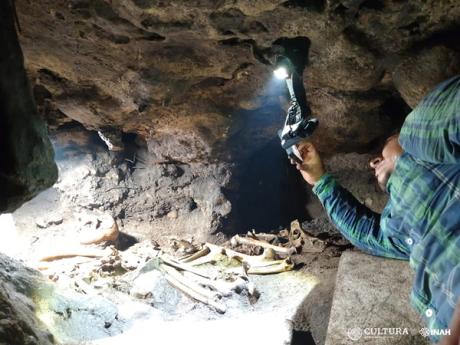
Mexican archaeologists from the National Institute of Anthropology and History (INAH) have discovered a Maya burial site at the archaeological complex in Tulum, Quintana Roo, while planning a new path between ancient structures.The tomb, hidden inside a cave, contained the remains of eight humans and various animals, likely buried together in funeral ceremonies. All materials have been described as well preserved, and are being studied further at INAH’s Quintana Roo Center by the head of the department of physical anthropology, Allan Ortega Muñoz.To access the burial site, archaeologists had to move a boulder sealing the cave’s opening, causing unforeseen damage to their findings.The project’s coordinator José Antonio Reyes Solís said in a statement that upon removing the boulder blocking the cave’s entrance, researchers saw that it had been splitting the ossified remains of an individual, leaving the lower part of the body on the outside and the upper part inside.Once beyond the entrance to the burial site, researchers catalogued the remains, as well as the bones of domestic dogs, deer, armadillo, birds, turtles and tiger sharks. While some bones were assumed to belong to bodies of animals buried alongside the humans, others contained scratches and deformations characteristic of tools. Aside from buried remains, a snail was found glued atop the front wall of the cave, something specialists identified as a Maya decorative element.A partial view of the ancient burial chamber at Tulum Courtesy National Institute of Anthropology and History (INAH)Testimony from archaeologists describes the conditions inside the cave as particularly difficult, as the small entryways, low ceilings, lack of natural light, and general heat and humidity complicate the documentation process. In addition to photographs, a 3D scan of the space will be created, so that researchers and members of the public will be able to view materials and remains in context.News of the cave’s discovery coincides with the launch of the controversial Tren Maya, a nearly $30bn train line connecting tourist hubs in Mexico’s Yucatán peninsula. Throughout the construction of the project, environmental and archaeological activists protested the train’s disruptions to six nearby Unesco World Heritage sites and around 25,000 new archaeological sites, as well as subterranean caves similar to the burial site discovered in Tulum. In an attempt to account for the project’s impact on the environmentally and archaeologically sensitive region, the Mexican government has announced a new museum, which will display artefacts unearthed during the building of the Tren Maya.Watch INAH’s video tour inside the newly discovered burial chamber at Tulum:


























